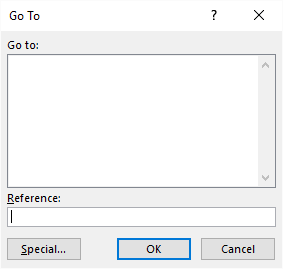Please Note: This article is written for users of the following Microsoft Excel versions: 2007, 2010, 2013, 2016, 2019, and 2021. If you are using an earlier version (Excel 2003 or earlier), this tip may not work for you. For a version of this tip written specifically for earlier versions of Excel, click here: Selecting Noncontiguous Ranges with the Keyboard.
Written by Allen Wyatt (last updated July 31, 2024)
This tip applies to Excel 2007, 2010, 2013, 2016, 2019, and 2021
Most people know that you can select a noncontiguous range of cells by using the mouse. All you need to do is click the first cell in the range and then hold down the Ctrl key as you click other cells in the range. (This is often referred to as creating a selection set of cells.)
Some folks don't like using the mouse that much. If you are in that camp, you may wonder if there is a way to select a noncontiguous range simply by using the keyboard. Fortunately there is, but very few folks know about it. Provided that you know the addresses of the cells you want in the range, follow these steps:

Figure 1. The Go To dialog box.
As an example, if you wanted your noncontiguous range to include cells A7, B2, F14 through G22, and T18, you would enter the following into the Reference box:
A7,B2,F14:G22,T18
Clicking OK then selects all these cells. In addition, the last cell that you entered is the "active cell" in the selected range.
ExcelTips is your source for cost-effective Microsoft Excel training. This tip (10919) applies to Microsoft Excel 2007, 2010, 2013, 2016, 2019, and 2021. You can find a version of this tip for the older menu interface of Excel here: Selecting Noncontiguous Ranges with the Keyboard.

Program Successfully in Excel! This guide will provide you with all the information you need to automate any task in Excel and save time and effort. Learn how to extend Excel's functionality with VBA to create solutions not possible with the standard features. Includes latest information for Excel 2024 and Microsoft 365. Check out Mastering Excel VBA Programming today!
If you have a lot of text in your workbook, at some point you might want to split out sentences into individual cells. ...
Discover MoreNeed to get rid of everything in a worksheet except for your formulas? You can do it rather easily by applying the ideas ...
Discover MoreNeed to limit the number of characters that can be entered into a cell? One easy way to do it is through the use of Data ...
Discover MoreFREE SERVICE: Get tips like this every week in ExcelTips, a free productivity newsletter. Enter your address and click "Subscribe."
2020-02-08 10:39:13
Mark
Thank you for sticking up for (or at least acknowledging) us keyboard warriors.
Are we misomusonists? That's a word I think I just made up for dislike of mice - in my case computer mice ;-)
Got a version of Excel that uses the ribbon interface (Excel 2007 or later)? This site is for you! If you use an earlier version of Excel, visit our ExcelTips site focusing on the menu interface.
FREE SERVICE: Get tips like this every week in ExcelTips, a free productivity newsletter. Enter your address and click "Subscribe."
Copyright © 2026 Sharon Parq Associates, Inc.
Comments